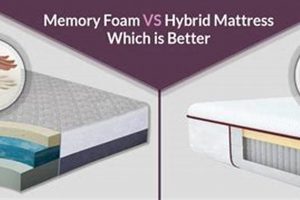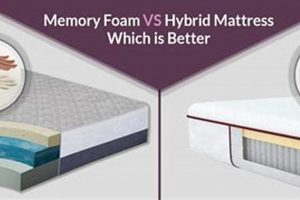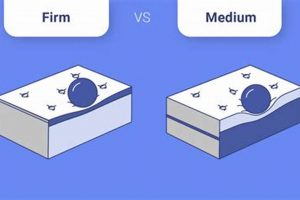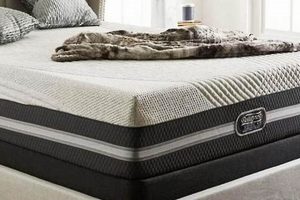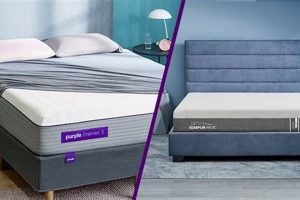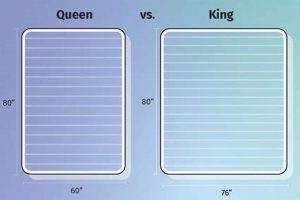A flat, generally thin layer designed to shield a sleep surface from spills, stains, and other potential damage can be distinguished from an item created to add comfort or alter the feel of a bed. For example, one might encounter a waterproof sheet designed to prevent liquids from soaking into the mattress, while the other could be a quilted layer intended to soften a firm sleeping surface.
Understanding the distinct functions offers significant value, influencing the lifespan of the primary sleep surface and impacting the overall quality of rest. Historically, protecting a bed has been a concern, evolving from basic coverings to technologically advanced materials. The benefits of employing either option extend to hygiene, allergy control, and investment preservation.
The following will delve into the nuanced differences, exploring construction materials, primary functions, suitability for various needs, and practical considerations for choosing the most appropriate option to enhance and safeguard a sleep environment.
Selection Guidance
Careful consideration of individual requirements is essential when choosing between options. Evaluating needs and priorities regarding protection versus comfort is crucial for informed decision-making.
Tip 1: Assess Primary Need: Determine whether the primary goal is to safeguard the mattress from spills and allergens, or to enhance the sleeping surface’s comfort level.
Tip 2: Review Material Composition: Examine the materials used in construction, considering factors such as breathability, waterproofing, and potential allergens. Opt for materials that align with individual sensitivities and desired performance characteristics.
Tip 3: Evaluate Thickness and Profile: Consider the thickness and profile, especially in relation to existing bedding. A thicker option will noticeably alter the bed’s feel, while a low-profile choice offers discreet protection.
Tip 4: Check for Secure Fit: Ensure the chosen option has a secure fitting mechanism, such as elasticized corners or fitted skirts, to prevent shifting during sleep.
Tip 5: Consider Washability: Verify the ease of cleaning and maintenance. Machine-washable options offer convenience and promote hygiene.
Tip 6: Evaluate Warranty and Certifications: Research the warranty provided and any relevant certifications, indicating quality standards and product safety.
Tip 7: Read Product Reviews: Consult product reviews from other users to gain insights into real-world performance and durability.
These considerations facilitate a focused selection process, aligning the final choice with both practical and personal needs. Addressing protection and comfort contributes to a healthy and comfortable sleep environment.
Ultimately, these considerations provide a framework for selecting the most appropriate product, ensuring both longevity and an enhanced sleep experience.
1. Protection Level
Protection level is a primary distinguishing factor between a mattress pad and a protector, influencing the selection process and suitability for specific needs. A protector is fundamentally designed to shield the mattress from liquids, stains, allergens, and bed bugs. This is typically achieved through a waterproof or water-resistant membrane integrated into its construction. For example, a protector used in a child’s bed directly reduces the risk of mattress damage from spills or accidents, extending the mattress lifespan. The higher the protection level offered, the greater the capacity to prevent damage from external elements. Failure to implement adequate protection can result in irreversible staining, microbial growth, and voided warranty claims.
Conversely, while some mattress pads offer a degree of surface-level protection, their primary function is comfort enhancement. They typically lack the robust barrier properties found in protectors, rendering them less effective against significant liquid intrusion or allergen penetration. A mattress pad might safeguard against minor soiling or perspiration, but it will not adequately protect against a spilled glass of water. The level of protection inherent in the product determines its suitability for specific use cases, such as households with young children, pets, or individuals with allergies.
In summary, the protection level offered is a critical consideration when evaluating a mattress pad and a protector. Choosing the correct option based on anticipated exposure to potential damage can significantly affect the mattress’s longevity and overall hygiene. While both products contribute to a more comfortable sleep environment, their respective abilities to prevent damage differentiate their roles.
2. Comfort Enhancement
Comfort enhancement serves as a pivotal aspect when differentiating between a mattress pad and a protector. The former is frequently employed to alter the sleep surface’s feel, offering increased cushioning or support. This enhancement is achieved through the incorporation of materials like memory foam, down alternatives, or quilted fabrics. For instance, an individual with a firm mattress might add a padded layer to soften the sleeping experience. Comfort enhancement, as a design feature, directly addresses subjective preferences related to mattress firmness and overall sleep quality. The degree of enhancement depends on the pad’s thickness, material density, and construction methods.
Conversely, the protector’s primary purpose is safeguarding the mattress, with comfort being a secondary consideration. While some protectors may incorporate thin layers of padding, their impact on the bed’s overall feel is generally minimal. Protectors prioritize impermeability and allergen resistance over substantial changes to the sleep surface’s characteristics. For example, a waterproof protector might add a slight layer of cushioning, but its impact is negligible compared to a dedicated mattress pad. The practical significance lies in recognizing that increased protection may come at the expense of maximal comfort enhancement.
In summary, the role of comfort enhancement in determining the appropriate choice hinges on individual priorities. If the primary goal is to modify the sleep surface’s feel, a mattress pad designed for comfort is the more suitable option. If, however, the emphasis is on protecting the mattress from damage and allergens, a protector, perhaps with a minimal degree of padding, should be selected. The optimal choice balances these factors based on individual needs and preferences, considering that neither option inherently precludes the other; both may be employed concurrently to achieve both protection and enhanced comfort.
3. Material Composition
The selection of materials significantly dictates the performance and suitability of either a mattress pad or a protector. A thorough examination of constituent materials is essential for informed decision-making, as it directly affects comfort, durability, protection level, and maintenance requirements.
- Fiber Type: Natural vs. Synthetic
Natural fibers, such as cotton, wool, or bamboo, offer breathability and moisture-wicking properties, enhancing comfort and potentially reducing allergens. Synthetic fibers, including polyester or microfiber, often provide enhanced durability, stain resistance, and lower cost. The choice between natural and synthetic materials depends on individual priorities, balancing comfort with practicality. For example, a protector utilizing a synthetic waterproof membrane offers superior liquid protection, while a pad made of natural cotton promotes airflow and temperature regulation.
- Waterproof Barrier Materials
Protectors frequently incorporate waterproof barriers like polyurethane or thermoplastic polyurethane (TPU). These materials prevent liquids from penetrating the mattress, protecting against spills and stains. However, the breathability of these materials can vary, with some newer TPU membranes offering improved airflow compared to traditional polyurethane. The selection of a waterproof barrier impacts both the protective capability and the overall comfort of the sleep surface. A less breathable material may lead to increased heat retention and discomfort, while a more breathable option enhances comfort but may compromise on absolute waterproofness.
- Fill Materials: Padding and Cushioning
Mattress pads commonly utilize fill materials to enhance comfort and alter the feel of the mattress. Options include memory foam, down alternatives (such as polyester clusters), and natural fills like down feathers. Memory foam contours to the body, providing pressure relief but potentially retaining heat. Down alternatives offer a similar cushioning effect with improved breathability and hypoallergenic properties. The selection of fill material directly influences the level of comfort and support provided, as well as the pad’s overall thickness and weight. A thicker pad with a high-density fill will significantly alter the feel of the underlying mattress.
- Construction and Weave
The construction and weave of the materials also contribute to the performance. Tightly woven fabrics offer increased durability and resistance to allergens, while looser weaves promote airflow. Quilted constructions distribute fill materials evenly and prevent shifting. The specific construction techniques employed affect the pad or protector’s overall lifespan, washability, and ability to maintain its shape and integrity over time. For instance, a protector with reinforced seams and a tightly woven outer layer will offer greater resistance to wear and tear.
In summary, material composition is a critical determinant in differentiating between a mattress pad and a protector. The selection of fiber type, waterproof barrier, fill material, and construction method all contribute to the final product’s performance, comfort, and protective capabilities. By carefully considering these factors, individuals can select the option that best aligns with their specific needs and priorities, ensuring both a comfortable and protected sleep environment.
4. Maintenance Requirements
Maintenance requirements represent a key differentiator, influencing both the long-term cost and practical convenience associated with mattress pads and protectors. The frequency and complexity of cleaning and care procedures directly impact the lifespan, hygiene, and overall user experience of these bedding accessories.
- Washability and Drying
The ability to machine wash and dry either a pad or a protector significantly affects its upkeep. Protectors, designed to repel liquids, often require specific washing instructions to maintain their waterproof integrity. High heat during drying may damage the waterproof membrane, necessitating low-temperature or air-drying methods. Conversely, mattress pads, particularly those with bulky fill materials like memory foam or down alternatives, may require commercial-sized washing machines or professional cleaning services. Understanding these limitations is crucial for ensuring proper maintenance and preventing damage.
- Stain Resistance and Treatment
While protectors aim to prevent stains from reaching the mattress, both pads and protectors themselves are susceptible to staining from spills, sweat, or body oils. Protectors with stain-resistant finishes simplify spot cleaning and minimize the need for frequent washing. Mattress pads, especially those made from natural fibers, may require specialized stain removal treatments to prevent discoloration or permanent staining. The ease with which stains can be removed directly impacts the visual appeal and hygienic condition of the bedding accessory.
- Allergen Control and Cleaning Frequency
Both pads and protectors can accumulate dust mites, allergens, and other microscopic particles over time. Regular washing, ideally in hot water, is essential for controlling allergen levels and maintaining a healthy sleep environment. The recommended washing frequency varies depending on the material composition and individual sensitivity to allergens. Individuals with allergies or asthma may need to wash their pads and protectors more frequently than those without such sensitivities. The ability to effectively remove allergens during washing is a critical factor in selecting a suitable product.
- Durability and Longevity
The long-term durability of a pad or protector directly affects its maintenance requirements. Products made from high-quality materials and featuring robust construction are more likely to withstand repeated washing and resist wear and tear. Low-quality materials may degrade rapidly, requiring frequent replacement and increasing the overall cost of ownership. Evaluating the product’s expected lifespan and resistance to damage is essential for determining its long-term value and minimizing maintenance-related expenses.
In conclusion, the maintenance requirements associated with mattress pads and protectors are diverse and significantly influence their practicality. Factors such as washability, stain resistance, allergen control, and durability must be carefully considered to select an option that aligns with individual lifestyles and preferences. Prioritizing ease of maintenance not only saves time and effort but also ensures the long-term hygiene and performance of the chosen bedding accessory, safeguarding the investment in sleep quality.
5. Price Point
The economic aspect presents a crucial element when differentiating between a mattress pad and a protector, impacting the purchase decision. Generally, protectors, designed with a focus on barrier protection against liquids and allergens, exhibit a lower price point compared to their pad counterparts. This cost disparity stems from the relatively simpler construction and the use of less material in many protector designs. For example, a basic waterproof protector might retail for $30-$50, providing essential safeguarding without substantial comfort enhancement. The cost-effectiveness of protectors makes them an attractive option for budget-conscious consumers seeking fundamental mattress preservation.
Conversely, mattress pads, often featuring thicker construction, premium fill materials like memory foam or down alternatives, and enhanced comfort features, typically command a higher price. These elevated costs reflect the additional materials, sophisticated manufacturing processes, and focus on altering the sleep surface’s feel. For instance, a high-end mattress pad with memory foam and temperature-regulating technology can easily exceed $100 or even $200. The added comfort and potential improvements to sleep quality associated with these pricier pads justify the investment for consumers prioritizing a more luxurious sleep experience. The price difference, therefore, reflects the divergence in functional priorities and material composition.
In summary, the price point serves as a significant differentiator between mattress pads and protectors. While protectors offer an economical solution for basic mattress protection, pads prioritize comfort enhancement, incurring a higher cost. The optimal choice necessitates aligning budget considerations with individual needs and priorities. Recognizing the correlation between price, features, and performance allows consumers to make informed purchasing decisions, ensuring they receive the desired level of protection and comfort within their budgetary constraints. Understanding the ‘price point’ is essential, yet it is also crucial to remember that one shouldn’t consider price as the sole determining factor, but also the features and benefits.
Frequently Asked Questions
The following addresses common inquiries regarding the differentiation and appropriate use of mattress pads and protectors. The information is intended to clarify their distinct functions and assist in making informed purchasing decisions.
Question 1: What constitutes the primary distinction between a mattress pad and a protector?
The primary distinction lies in their intended function. A protector is designed to shield the mattress from liquids, stains, allergens, and bed bugs. A pad, conversely, primarily aims to enhance the comfort of the sleep surface.
Question 2: Is a mattress pad sufficient to safeguard against liquid spills?
Generally, a mattress pad is not sufficient. While some pads may offer a degree of absorbency, they lack the waterproof or water-resistant barrier necessary to prevent liquids from penetrating the mattress. A dedicated protector with a waterproof membrane is required for effective spill protection.
Question 3: How does the material composition influence the choice between a mattress pad and a protector?
Material composition affects comfort, durability, and protective capabilities. Protectors frequently employ waterproof materials like polyurethane, while pads utilize fill materials such as memory foam or down alternatives to enhance comfort. Consideration of material properties is crucial for aligning the choice with individual needs and preferences.
Question 4: What maintenance procedures are recommended for mattress pads and protectors?
Maintenance procedures vary depending on the product’s construction. Protectors often require specific washing instructions to preserve their waterproof integrity. Pads may necessitate commercial-sized washing machines or professional cleaning services due to their bulkier fill materials. Regular washing is generally recommended for both to control allergen levels.
Question 5: Does a higher price point necessarily indicate superior quality in both mattress pads and protectors?
A higher price point does not automatically guarantee superior quality. Price often reflects enhanced comfort features or premium materials in pads, while protectors may remain relatively inexpensive due to their simpler construction. Assessing the specific features and materials is more important than solely relying on price.
Question 6: Can a mattress pad and a protector be used concurrently?
Yes, a mattress pad and a protector can be used simultaneously. This approach allows for both enhanced comfort and robust mattress protection. It is important, however, to ensure that the combination does not compromise breathability or create an excessively thick sleep surface.
In summary, the selection hinges on aligning individual priorities regarding protection, comfort, and budget. Understanding the distinct functions, material properties, and maintenance requirements enables informed decision-making.
The subsequent section will present a conclusive overview, consolidating key considerations for choosing between a mattress pad and a protector.
Conclusion
The exploration of mattress pad vs protector reveals distinct roles and functions vital for informed consumer choice. A protector primarily shields the mattress from damage, extending its lifespan and safeguarding against allergens. A pad, conversely, enhances comfort and alters the feel of the sleeping surface. Material composition, maintenance requirements, and price point further differentiate these products, demanding careful evaluation based on individual priorities.
Ultimately, the selection dictates not only the longevity of the mattress investment but also the quality of the sleep experience. Prioritizing either protection or comfort, or strategically combining both, will contribute to a more hygienic and restful sleep environment. Continued advancements in material technology promise further refinements in both protective capabilities and comfort enhancement, necessitating ongoing awareness of product innovations.


